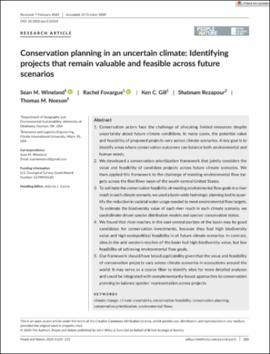| dc.contributor.author | Wineland, Sean M. | |
| dc.contributor.author | Fovargue, Rachel | |
| dc.contributor.author | Gill, Ken C. | |
| dc.contributor.author | Rezapour, Shabnam | |
| dc.contributor.author | Neeson, Thomas M. | |
| dc.date.accessioned | 2021-02-11T21:28:07Z | |
| dc.date.available | 2021-02-11T21:28:07Z | |
| dc.date.issued | 2020-12-21 | |
| dc.identifier.uri | https://hdl.handle.net/11244/328590 | |
| dc.description.abstract | Conservation actors face the challenge of allocating limited resources despite uncertainty about future climate conditions. In many cases, the potential value and feasibility of proposed projects vary across climate scenarios. A key goal is to identify areas where conservation outcomes can balance both environmental and human needs. We developed a conservation prioritization framework that jointly considers the value and feasibility of candidate projects across future climate scenarios. We then applied this framework to the challenge of meeting environmental flow targets across the Red River basin of the south‐central United States. To estimate the conservation feasibility of meeting environmental flow goals in a river reach in each climate scenario, we used a basin‐wide hydrologic planning tool to quantify the reduction in societal water usage needed to meet environmental flow targets. To estimate the biodiversity value of each river reach in each climate scenario, we used climate‐driven species distribution models and species’ conservation status. We found that river reaches in the east‐central portion of the basin may be good candidates for conservation investments, because they had high biodiversity value and high sociopolitical feasibility in all future climate scenarios. In contrast, sites in the arid western reaches of the basin had high biodiversity value, but low feasibility of achieving environmental flow goals. Our framework should have broad applicability given that the value and feasibility of conservation projects vary across climate scenarios in ecosystems around the world. It may serve as a coarse filter to identify sites for more detailed analyses and could be integrated with complementarity‐based approaches to conservation planning to balance species’ representation across projects. | en_US |
| dc.description.sponsorship | This research was supported by S.M.W.'s Science to Action Fellowship through the National Climate Adaptation Science Center at the US Geological Survey. U.S. Geological Survey. Grant Number: G17AP00120
Open Access fees paid for in whole or in part by the University of Oklahoma Libraries. | en_US |
| dc.rights | Attribution 4.0 International | * |
| dc.rights.uri | https://creativecommons.org/licenses/by/4.0/ | * |
| dc.subject | Climate Uncertainty | en_US |
| dc.subject | Conservation Feasibility | en_US |
| dc.subject | Conservation Planning | en_US |
| dc.subject | Climate Change | en_US |
| dc.subject | Conservation Prioritization | en_US |
| dc.subject | Environmental Flows | en_US |
| dc.title | Conservation planning in an uncertain climate: Identifying projects that remain valuable and feasible across future scenarios | en_US |
| dc.type | Article | en_US |
| dc.description.peerreview | Yes | en_US |
| dc.identifier.doi | 10.1002/pan3.10169 | en_US |
| ou.group | College of Atmospheric and Geographic Sciences::Department of Geography and Environmental Sustainability | en_US |


